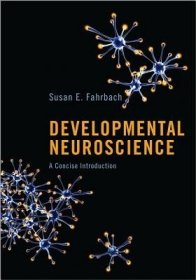
现货Developmental Neuroscience: A Concise Introduction[9780691150987]
¥ 742 九五品
仅1件
作者Fahrbach, Susan E
出版社Princeton University Press
ISBN9780691150987
出版时间2013-08
装帧精装
纸张其他
页数320页
正文语种英语
上书时间2024-03-27
- 最新上架
商品详情
- 品相描述:九五品
- 商品描述
- A concise introductory textbook on the development of the nervous systemThis textbook offers a concise introduction to the exciting field of developmental neuroscience, a discipline concerned with the mechanisms by which complex nervous systems emerge during embryonic growth. Bridging the divide between basic and clinical research, it captures the extraordinary progress that has been achieved in the field. It provides an opportunity for students to apply and extend what they have learned in their introductory biology courses while also directing them to the primary literature.This accessible textbook is unique in that it takes an in-depth look at a small number of key model systems and signaling pathways. The book's chapters logically follow the sequence of human brain development and explain how information obtained from models such as Drosophila and zebrafish addresses topics relevant to this area. Beginning with a brief presentation of methods for studying neural development, the book provides an overview of human development, followed by an introduction to animal models. Subsequent chapters consider the molecular mechanisms of selected earlier and later events, neurogenesis, and formation of synapses. Glial cells and postembryonic maturation of the nervous system round out later chapters. The book concludes by discussing the brain basis of human intellectual disabilities viewed from a developmental perspective.Focusing on the mechanistic and functional, this textbook will be invaluable to biology majors, neuroscience students, and premedical and pre-health-professions students.An accessible introduction to nervous system developmentSuitable for one-semester developmental neuroscience courseThorough review of key model systemsSelective coverage of topics allows professors to personalize coursesInvestigative reading exercises at the end of each chapterAn online illustration package is available to professors
相关推荐
-
![现货Developmental Research Methods[9781506332017]](https://www0.kfzimg.com/sw/kfz-cos/kfzimg/17733071/ddd3dae5a7796ee9_s.jpg)
现货Developmental Research Methods[9781506332017]
九五品上海
¥ 1087.00
-
![现货Comorbidities in Developmental Disorders[9781907655005]](https://www0.kfzimg.com/sw/kfz-cos/kfzimg/17733071/151d007fb0a2af70_s.jpg)
现货Comorbidities in Developmental Disorders[9781907655005]
九五品上海
¥ 1002.00
-
![现货 Developmental Neuroscience and Imaging[9781848290242]](https://www0.kfzimg.com/sw/kfz-cos/kfzimg/17733071/f9c4d4c49175054e_s.jpg)
现货 Developmental Neuroscience and Imaging[9781848290242]
九五品上海
¥ 506.00
-
![现货 Reproductive and Developmental Toxicology[9780128042397]](https://www0.kfzimg.com/sw/kfz-cos/kfzimg/17733071/b7cecfcd4f09d736_s.jpg)
现货 Reproductive and Developmental Toxicology[9780128042397]
九五品上海
¥ 2104.00
-
![现货 Handbook of Developmental Neurotoxicology[9780128094051]](https://www0.kfzimg.com/sw/kfz-cos/kfzimg/17733071/a3370510c90347b0_s.jpg)
现货 Handbook of Developmental Neurotoxicology[9780128094051]
九五品上海
¥ 1893.00
-
![现货 Reproductive and Developmental Toxicology[9780123820327]](https://www0.kfzimg.com/sw/kfz-cos/kfzimg/17733071/3a2d10c1d3b6ca28_s.jpg)
现货 Reproductive and Developmental Toxicology[9780123820327]
九五品上海
¥ 2230.00
-
![现货 Handbook of Developmental Psychiatry[9789814324816]](https://www0.kfzimg.com/sw/kfz-cos/kfzimg/17733071/1f8241a6ce2e6531_s.jpg)
现货 Handbook of Developmental Psychiatry[9789814324816]
九五品上海
¥ 1630.00
-
![现货Aap Developmental and Behavioral Pediatrics[9781610021340]](https://www0.kfzimg.com/sw/kfz-cos/kfzimg/17733071/2c4dfa8cccd926f6_s.jpg)
现货Aap Developmental and Behavioral Pediatrics[9781610021340]
九五品上海
¥ 843.00
-

DEVELOPMENTAL BIOLOGY
九品北京
¥ 30.00
-

DEVELOPMENTAL PSYCHOPATHOLOGY
八五品长沙
¥ 60.00
— 没有更多了 —
![现货Developmental Neuroscience: A Concise Introduction[9780691150987]](https://www0.kfzimg.com/sw/kfz-cos/kfzimg/17733071/47045cdeaa8b403b_b.jpg)

![现货Materials and Technologies of Modern Production[9783036401683]](https://www0.kfzimg.com/sw/kfz-cos/kfzimg/17733071/5fd2824531e165d7_s.jpg)
![现货Introduction to Container Ship Operations and Onboard Safety[9781032155425]](https://www0.kfzimg.com/sw/kfz-cos/kfzimg/17733071/58b7ff43ef7909ee_s.jpg)
![现货Electrophosphorescent Materials and Devices[9789814877343]](https://www0.kfzimg.com/sw/kfz-cos/kfzimg/17733071/18cc1d77bcb7b488_s.jpg)
![现货Organic Semiconductors for Optoelectronics[9781119146100]](https://www0.kfzimg.com/sw/kfz-cos/kfzimg/17733071/24c85a750c708964_s.jpg)
![现货Advances in Food Rheology and Its Applications[9780081004319]](https://www0.kfzimg.com/sw/kfz-cos/kfzimg/17733071/e0c11603c9119d4d_s.jpg)
![现货Advanced Materials and Sustainable Technologies[9783035727562]](https://www0.kfzimg.com/sw/kfz-cos/kfzimg/17733071/dced675333874c48_s.jpg)
![现货Advanced Materials and Manufacturing Engineering II[9783035712681]](https://www0.kfzimg.com/sw/kfz-cos/kfzimg/17733071/660ccfae75fa8d3e_s.jpg)
![现货Materials in Machinery and Construction[9783035718119]](https://www0.kfzimg.com/sw/kfz-cos/kfzimg/17733071/6f402060775e9daa_s.jpg)
![现货Cereal Grain Quality (Softcover Reprint of the Original 1st 1996)[9789401071772]](https://www0.kfzimg.com/sw/kfz-cos/kfzimg/17733071/f93ca1c96a97403a_s.jpg)
![现货Developmental Neuroscience: A Concise Introduction[9780691150987]](/dist/img/error.jpg)
以下为对购买帮助不大的评价